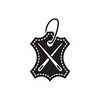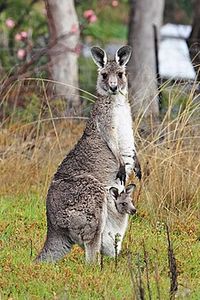Kangaroo
Kangaroo leather is a strong, lightweight leather derived from the hide of the kangaroo.
Kangaroos are harvested. Both the meat and the hides are sold. Although hunting most species of macropod is prohibited, a small number of the large-sized species with high populations can be hunted by commercial hunters. This policy has been criticised by some wildlife activists.
Terminology
The word kangaroo derives from the Guugu Yimithirr word gangurru, referring to eastern grey kangaroos. The name was first recorded as "kanguru" on 12 July 1770 in an entry in the diary of Sir Joseph Banks; this occurred at the site of modern Cooktown, on the banks of the Endeavour River, where HMS Endeavour under the command of Lieutenant James Cook was beached for almost seven weeks to repair damage sustained on the Great Barrier Reef. Cook first referred to kangaroos in his diary entry of 4 August. Guugu Yimithirr is the language of the people of the area.
A common myth about the kangaroo's English name is that it was a Guugu Yimithirr phrase for "I don't know" or "I don't understand". According to this legend, Cook and Banks were exploring the area when they happened upon the animal. They asked a nearby local what the creatures were called. The local responded "kangaroo", said to mean "I don't know/understand", which Cook then took to be the name of the creature. Anthropologist Walter Roth was trying to correct this legend as far back as in 1898, but few took note until 1972 when linguist John B. Haviland in his research with the Guugu Yimithirr people was able to confirm that gangurru referred to a rare large dark-coloured species of kangaroo. However, when Phillip Parker King visited the Endeavour River region in 1819 and 1820, he maintained that the local word was not kangaroo but menuah perhaps referring to a different species of macropod. There are similar, more credible stories of naming confusion, such as with the Yucatán Peninsula. Kangaroos are often colloquially referred to as "roos". Male kangaroos are called bucks, boomers, jacks, or old men; females are does, flyers, or jills; and the young ones are joeys. The collective noun for a group of kangaroos is a mob, court, or troupe.
Applications
The leather is used in a wide variety of shoes. The unique structure of kangaroo leather allows it to be cut down to be very thin, but still retain strength.
Kangaroo leather is also popular in the manufacture of motorbike leathers and is used for many other applications such as car upholstery, military, football and american football boots, and fashion accessories.
Kangaroo leather is the material of choice for making whips, as the strips can be cut thin to keep the whip flexible, without sacrificing durability.
Properties
Studies conducted by the Australian Commonwealth Scientific and Industrial Research Organisation (CSIRO) confirm that kangaroo is one of the strongest leathers of similar substance available.
When split thinly, kangaroo leather retains considerably more of the original tensile strength of the unsplit leather than does calf leather. When split to 20% of original thickness kangaroo retains 30 to 60% of the tensile strength of the unsplit hide. Calf split to 20% of original thickness, on the other hand, retains only 1–4% of original strength.
Kangaroo leather is lighter and stronger than the hide of a cow or goat. It has 10 times the tensile strength of cowhide and is 50% stronger than goatskin.
Studies of the morphology of kangaroo leather help explain its particular properties.
The collagen fibre bundles in cattle hide are arranged in a complex weaving pattern. The fibres are often at angles as much as 90 degrees to the skin surface. Cattle hide also contains sweat glands, erector pili muscles and a distinct gradation in elastin levels, concentrated in the upper part of the skin. Kangaroo hide on the other hand has been shown to have a highly uniform orientation of fibre bundles in parallel with the skin surface. It does not contain sweat glands or erector pili muscles, and elastin is evenly distributed throughout the skin thickness. This structural uniformity explains both the greater tensile strength of the whole leather and the greater retention of strength in splits. Bovine skin is much more complex in cross-section; in whole section it has many more weak points from which tears can start when placed under tension. In addition, when split the collagen fibres running at significant angles to the skin surface will be cut, becoming weak points.
Environmental aspects
The Australian kangaroo industry produces a range of meat and leather products from animals harvested from the wild under strict government-controlled management plans intended to ensure that the harvest is sustainable and humane. A wide cross section of Australian ecologists support the kangaroo industry as being both sustainable and environmentally wise. Many argue that kangaroos, native to Australia, are a more environmentally friendly livestock option than introduced sheep and cattle. The two most important facets of kangaroos' better ecological fit than European agricultural animals relate to their adaptation to Australia's aridity.
Kangaroos have small chest development and so require less water to breathe than placental mammals, which usually must expand a diaphragm, losing more moisture in respiration. Kangaroos just make small pants while immobile, and in motion expand and contract their lungs effectively using their leg muscles. The belly flops up, contracting the lungs, and down, expanding them.
The kangaroo's paws are softer and do not compact the ground as hoofed cattle and sheep do. Instead, its hopping leaves very small bowl-shaped depressions in the surface of even dry clay soil, which let native grass seeds carried on the wind settle into them. The bowl shape concentrates any moisture that may fall into it into a wet point that the grass seed can use to germinate. Thus, kangaroos deplete the water table more slowly than cattle or sheep, and would even be viable in the absence of any bore water. The ecological arguments for kangaroos replacing sheep and cattle as arid land livestock are compelling, though they must be set against objections of kangaroos' lack of domestication and breeding rate.[citation needed] Kangaroos are eaten in most states.[citation needed]
See also
External links
Chat rooms • What links here • Copyright info • Contact information • Category:Root
| Articles related to leather working | |
|---|---|
| See also: |
|
| Types | |
| Substitutes | |
| Leather sources |
|
| Processes |
|
| Crafting |
|
| Hardware | |
| Tools | |
| Leather museums | Leather Archives and Museum |
| Related | |

